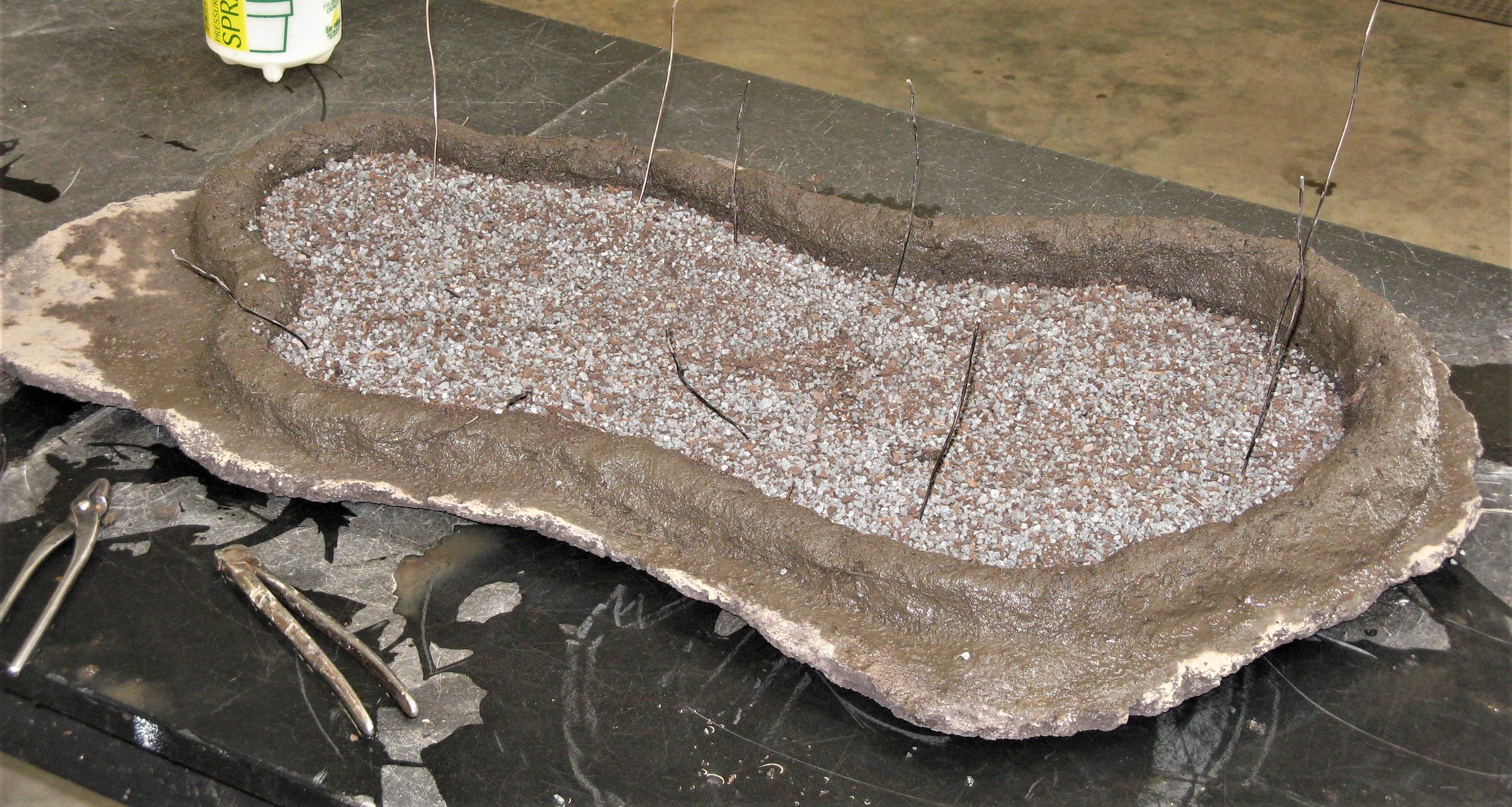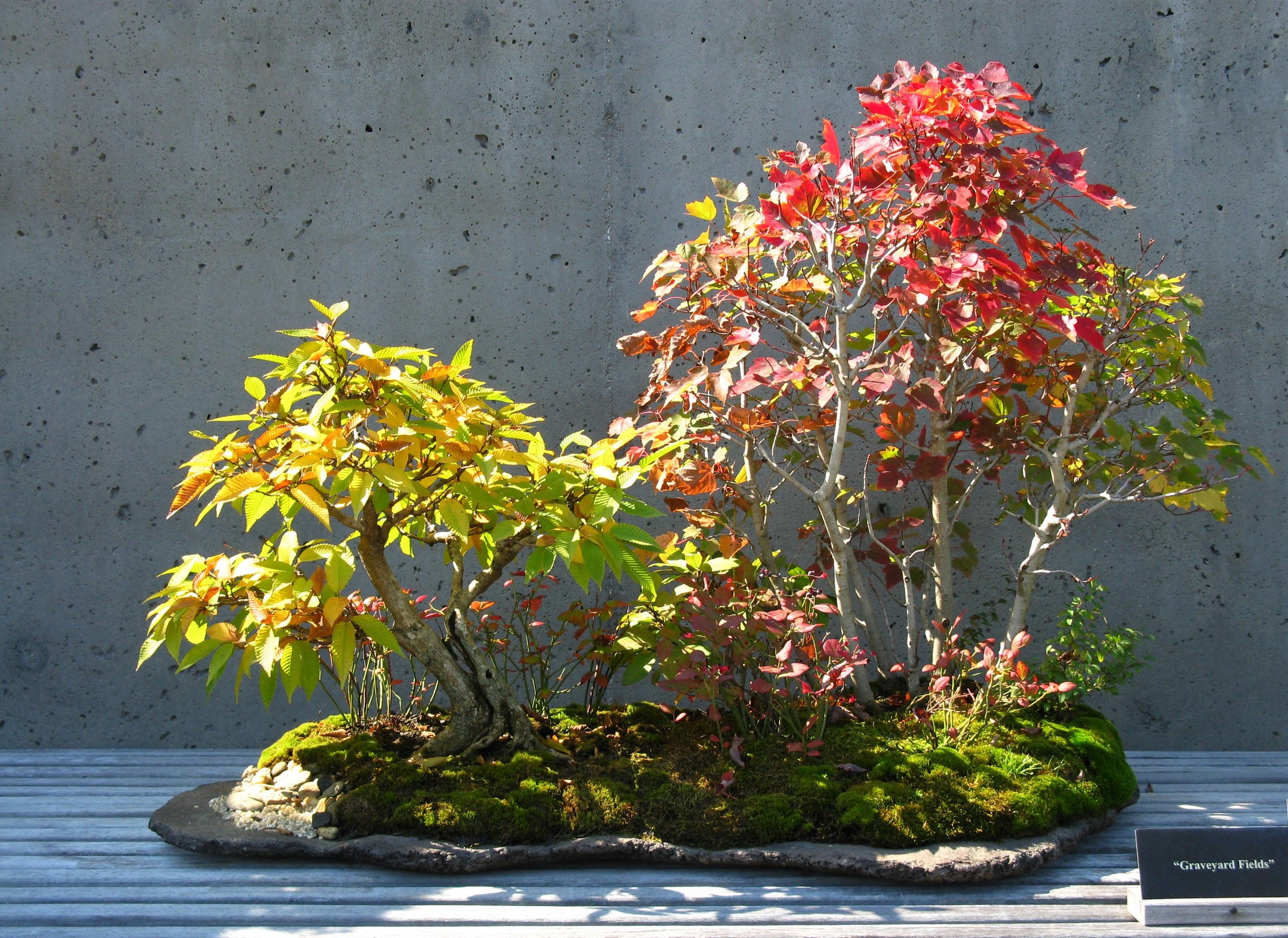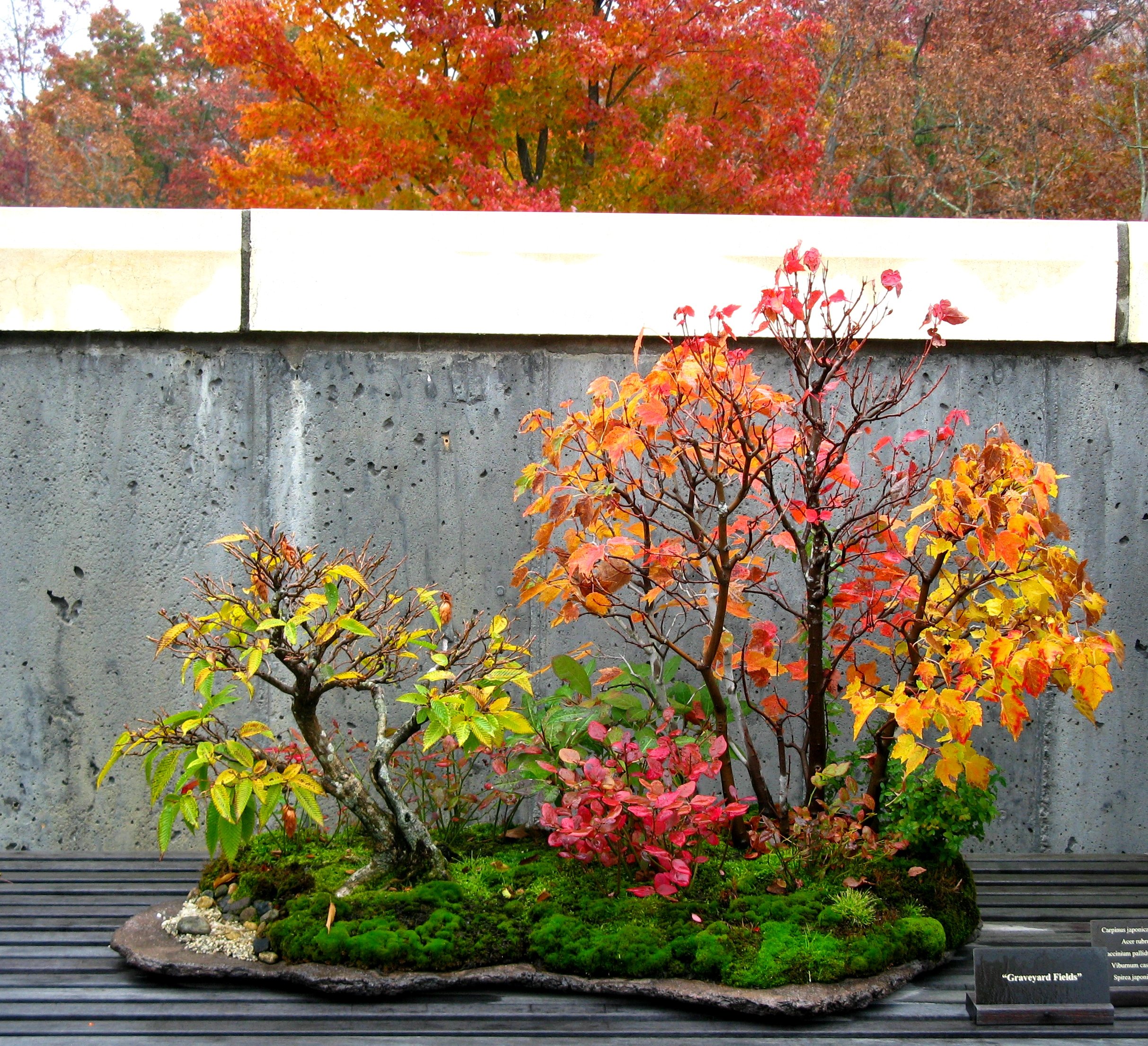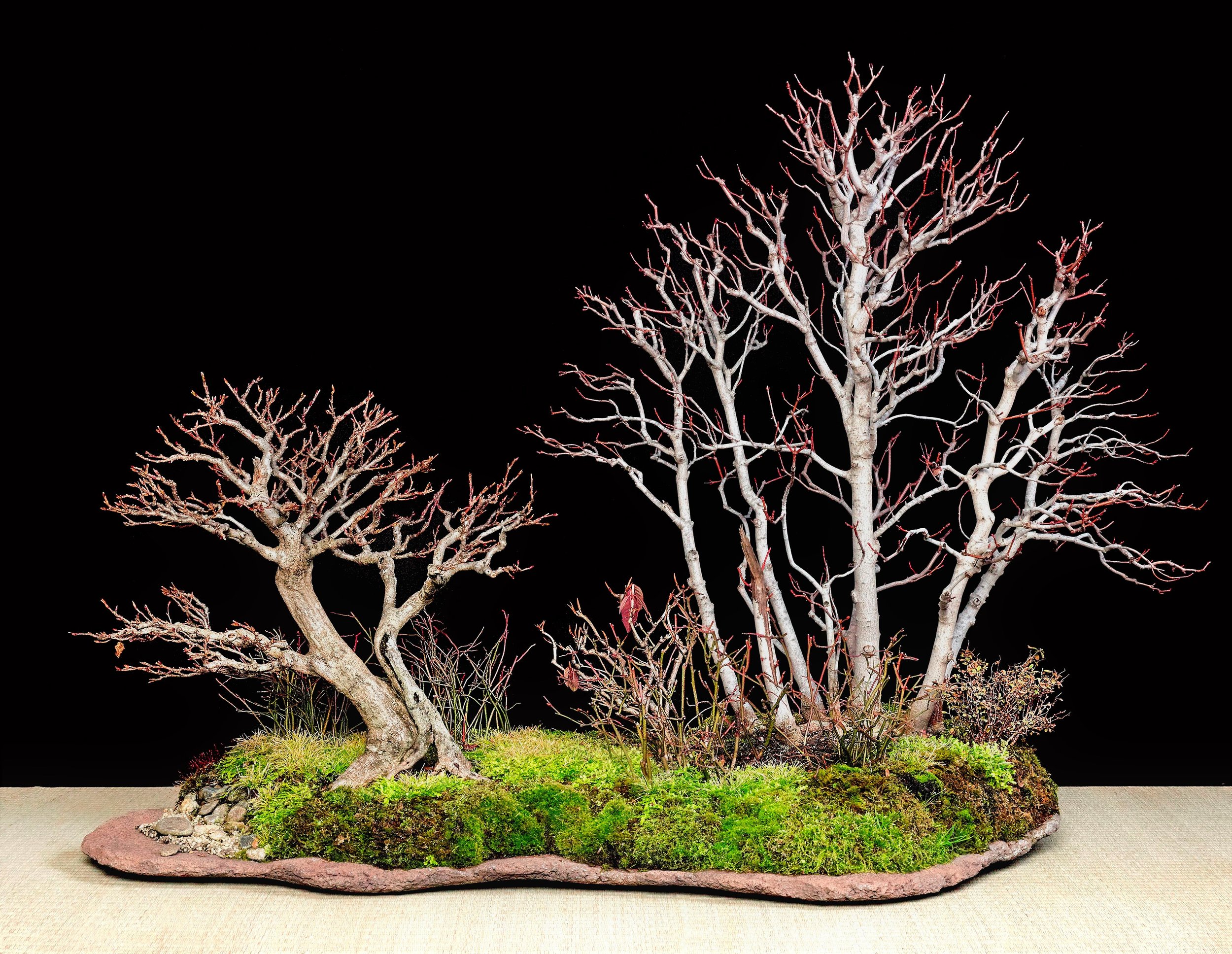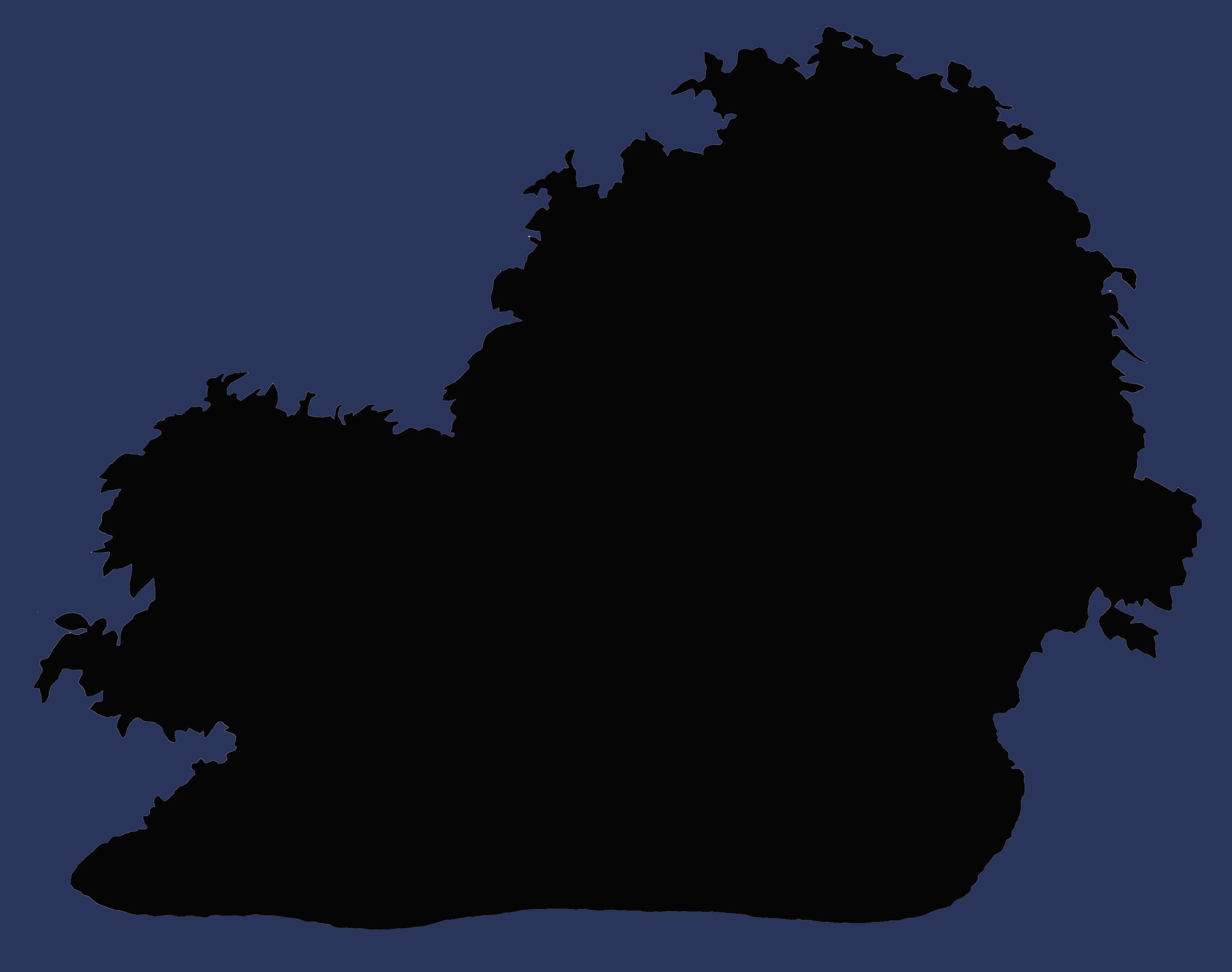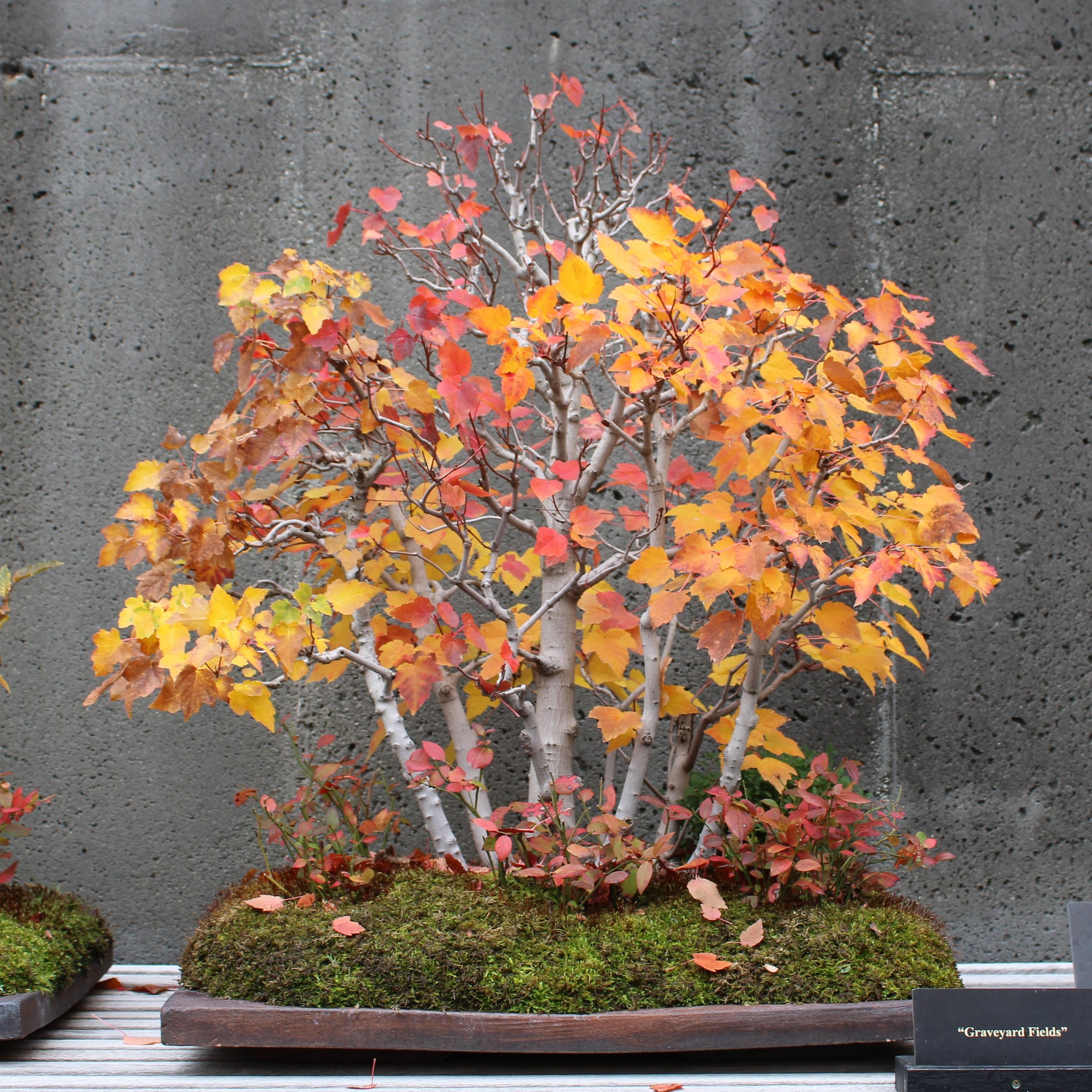Graveyard Fields - Part 2
The idea of using a wooden planter for a tray landscape had somehow become appealing to me early on. The box used for the Graveyard Fields planting was a first attempt at such, and provided lessons that helped improve the wooden planters we subsequently built for use. After ten years in the wooden container, however, it seemed Graveyard Fields was ready for a modification to its look. My South Carolina bonsai friend, Ken Duncan, in addition to being good with bonsai, was generally good with his hands. Ken went through a period where he was producing concrete slabs for bonsai use, very nicely crafted pieces with an organic feel to them, and he provided such a slab for Graveyard Fields. He built it to my specifications and I told him we wanted the slab to be a little bigger than the wooden tray we were currently using. That was a mistake. I should have asked Ken to make the new slab much larger, but I didn't realize that until later.
Here is a sequence illustrating the basic procedure followed when Graveyard Fields was transplanted from the wooden container to the new concrete slab:
The first image shows the slab prepared to receive the planting. The periphery of the soil mass in which the roots will live — its "footprint", so to speak — is established by a berm of muck. Muck is made by combining long-fibered sphagnum moss with peat in roughly equal measure and then adding water, kneading the stuff until it forms a clay-like, tacky lump of earthy material. This berm of muck acts like the walls of a pot, only roots are able to grow into it. Note, as well, the wires sticking up out of the slab. Ken provided the slab with numerous small holes, not for drainage but for accommodating the wires used to tie down the plants once they've been placed in the arrangement.
In the second image we see the plants of Graveyard Fields as they looked after being removed from the wooden container. The plants have been disassembled from the existing landscape configuration, their roots have been pruned, and now they are individual components ready to be replanted. At this stage the plants might be composed into a different arrangement if redesigning the planting is desired. In this instance, the same general layout as before would be followed. The hornbeam would be positioned on the left side next to the gravel and stones that suggest the Middle Prong, the group of red maples would be on the right side and the blueberries and other shrubs would be scattered in the openings between.
The third image depicts the plantings in place on the slab, just prior to when fresh growing medium would be introduced to the spaces around the separate root balls. It was at this point I first realized I should have asked Ken to make the slab larger. This new slab was bigger than the old wooden box, but all the extra room was lost when the berm was built to establish the new planting area. When planting on a slab it is almost always desirable to be able to see some of the slab exposed all around the planted area. That is to say, you generally don't want the edge of the soil mass to come right up to the edge of the slab. The area available for planting is therefore inevitably less than the overall size of the slab. Live and learn!
Despite failing to alleviate the crowding concern, the new slab gave Graveyard Fields a fresh and more open appearance. This photo from autumn of 2010 presents the planting on display in the bonsai garden:
Prior to when the above image was made and not long after being transplanted on the slab, Graveyard Fields was part of the Arboretum's display at the 2010 US National Bonsai Exhibition in Rochester, New York:
The full display looked like this:
In the years that followed, Graveyard Fields was regularly featured in the bonsai garden, always providing excellent seasonal interest (click on any image for full view):
In December of 2015 Graveyard Fields was once again formally exhibited at an indoor show. This time the venue was the Winter Silhouette Expo in Kannapolis, North Carolina:
As part of the Winter Silhouette event, all of the bonsai exhibited are professionally photographed. This high-quality image was made at that time and shows nicely the branch ramification acquired by all the plant material through fifteen years of close training:
Photo by Joe Noga
The following images are from 2019 (click on any image for full view):
It is only a coincidence, but an interesting one, that Graveyard Fields spent its first ten years planted in a wooden container and the next ten years planted on a concrete slab. Now, after twenty years of development it was once again time to change the look of this miniature landscape. As all the plants grew larger, the crowded feeling of the arrangement on the slab had become increasingly a concern. Bonsai cultural techniques slow down a plant's growth, but do not stop it. The planting needed more space both above and below the soil line in order to continue expressing itself through healthy, controlled growth. That concern was primarily horticultural, but there was an entirely aesthetical issue also related to the fact of the now too-small slab. The following illustrations will hopefully make the case.
Illustration 1 shows Graveyard Fields isolated against a solid backdrop:
Illustration 1
Illustration 2 shows just the lowest level of the planting, including the slab and the soil mass that sits on it. A dividing line has been drawn at the center of the image:
Illustration 2
First note that the soil mass actually overlaps the edge of the of the slab on the far right side of the planting. As previously stated, it is desirable that some of the slab be visible beyond the soil mass, as it is everywhere else except the far right side. I had pushed the maple group and understory plants as far to the right on the slab as I could to begin with, which brought the soil mass close to the edge, and then as years passed and the roots grew the mass expanded until the edge of the slab was overtaken.
Next, note in the above image how there is more empty blue space to the right of the slab than there is on the left. That is the opposite of how it should be. Keep in mind we are looking now at just the lowest section of the planting and not considering what is above it. A better balanced composition for an image showing just the lowest section of the planting would look like illustration 3:
Illustration 3
The composition of Graveyard Fields reads from right to left, and the slab is part of that arrangement. In speaking like this we are referring to the movement of the composition — although it really has to do with the movement of the human eye as it reads the composition. Experience teaches that it is more comfortable for the viewer to have a little extra space on the side of the composition that receives the eye movement. Consider illustration 4, showing just the upper section, without the slab and soil mass:
Illustration 4
The above image is once again divided by a centerline. The greater mass is plainly on the right side, and visual movement tends to go from areas of greater mass to areas of lesser mass. On the left side there is less mass and, consequently, more space. The movement in this image is from right to left, and there is extra space on the left to receive the movement. The above image features two asymmetrical halves combined to create one balanced whole.
Look again at illustration 3, where what we see is two asymmetrical halves that combine to create an unbalanced whole:
Illustration 3
Illustration 5 shows Graveyard Fields reassembled, with the lower level of the planting shifted to the right, where it needs to go in order to achieve balance, while the upper portion stays in place:
illustration 5
All this might be easier to convey if we look at the planting in silhouette. Illustration 6 shows the composition as it was in 2019 and illustration 7 shows the composition adjusted for better visual balance:
Illustration 6
Illustration 7
I apologize if readers now feel led off the path and into the weeds. It is often difficult to verbalize the thinking behind matters of visual concern, but such matters are paramount in bonsai — a visual art! I had been looking at Graveyard Fields and seeing this problem getting more pronounced as the years passed, and in 2019 it was time to do something about it. The planting called for a larger container or slab to accommodate ten years of accumulated growth, while the composition called for a foundation more in balance with everything above it.
I reached out to Ron Lang, one of the preeminent bonsai potters in the United States, and someone with whom the Arboretum had done business before. When I told Ron what we needed, he explained the difficulty of trying to make a ceramic slab as large as what we sought without having the work warp or break in the firing process. He then suggested a clever solution that happened to play perfectly into the concept of representing a large place like Graveyard Fields in a miniature scale. Instead of one slab, Ron proposed to make three.
The three ceramic slabs Ron made for us were each a different size. Two were larger, almost the same dimensions but a little different, and the third was considerably smaller. The largest slab received the group of red maples, along with several blueberry bushes and the one meadowsweet. The next largest slab received the Japanese hornbeam, a blueberry bush and a simple suggestion of the Middle Prong waterway (now more simplified than ever). The small slab received the one witherod viburnum, which had developed into an impressive shrubby specimen after twenty years of being kept small.
Graveyard Fields was transplanted to the new three-slab configuration in spring of 2020. It went right out on display in the bonsai garden and almost immediately a problem developed with the witherod on the smallest slab. When I noticed its sickly appearance I pulled it off display and transferred it to the hoop house, where it would be out of sight and under shade cloth. The two larger slabs remained out on display, however, and because no one knew there was supposed to be a third component of the composition it wasn't missed.
This photo was made in July of 2020:
I am not certain why I chose to display the two slabs side by side that year, but in 2022 a little space was introduced between them and the composition was better for it:
Autumn coloration was good in 2022, as it typically is for Graveyard Fields:
Being on separate slabs facilitated taking individual portraits of the separate components of the planting (click on either image for full view):
You might be wondering what became of the witherod viburnum that was planted on the smallest slab. Unfortunately, it continued to decline after being removed from display and eventually died. It was my fault this happened, because in my eagerness to have that nicely developed plant showcased on its own little slab I pushed it too far. The witherod had gone ten years without having its roots disturbed and then suddenly it was drastically root-pruned to make it fit a tight space. I should have known better.
In spring of 2023 I went into the woods out behind the hoop house and collected another dryland blueberry, then planted it on the smallest slab. With that done, it was finally possible to present Graveyard Fields in its new configuration, in its entirety:
At long last, the puzzle of representing a vast area in miniature form was solved. It was for me, anyway. By dedicating an eight-foot bench to this one landscape and then opening up space between the three components of the composition, the wide-open nature of the real Graveyard Fields is better suggested. The distance between the maple woods and the gnarly tree by the water's edge is much greater than the space between the two slabs that feature them. The little clump of blueberries on the smallest slab is actually across the Middle Prong from where the gnarly tree resides. It just takes the imagination of the viewer to make it so.
But that's always how it's supposed to work with bonsai.
The evolving look of Graveyard Fields:
2007
2016
2023

